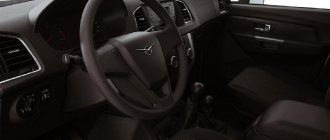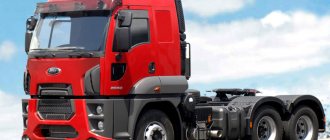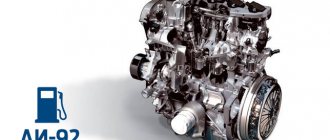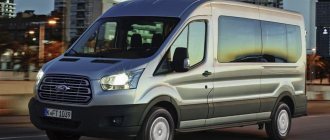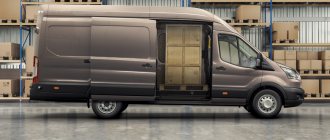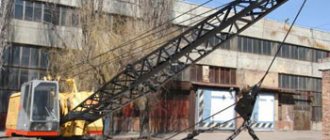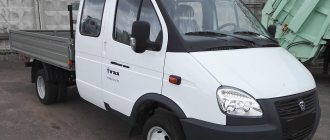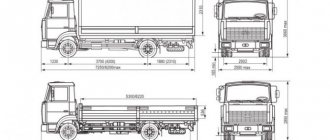Ford Cargo is a line of heavy trucks presented on the Russian market with a new generation - the Ford Cargo H476 model. The Ford Cargo family offers a wide range of carriers with a carrying capacity from 12,000 kg to 33,000 kg, the model range consists of: truck tractors, dump chassis, cargo chassis, chassis for car transporters.
On the Ford Cargo H476 chassis it is possible to install equipment for transporting liquid concrete (concrete mixer truck), insulated containers, flatbeds, dump platforms for transporting grain, etc.
The production of engines and transmissions with subsequent assembly of Ford Cargo takes place in Turkey. The Kocaeli plant (CARGO production), the Inonu plant (motors, gearboxes) are modern high-tech enterprises. The Ford Cargo H476 is equipped with Ecotorq six-cylinder diesel engines (power 260 hp, 320 hp, 350 hp) that meet the Euro-3 standard for CO2 emissions. The most powerful Ecotorq is 380 hp, it is also the “cleanest” and complies with Euro-5. Based on reviews, fuel consumption, depending on the engine, can be characterized as 30-40 liters per 100 km at full load.
Exterior of the new Ford Cargo. A car with a modern cabover cab on four-point air suspension, depending on the version with or without a berth (day).
To provide access to units for repair and maintenance, it is raised by 35 or 60 degrees. The metal cabin with anti-corrosion treatment is designed to comfortably accommodate the driver and one passenger. Comfort and safety are provided by air conditioning or climate control, central locking, electric cab, electric and heated mirrors, electric windows, heated windshield, heated driver's seat, pre-heating of the engine, radio, adjustable steering wheel for reach and tilt, driver's air suspension and passenger seats, on-board computer, tachograph, double seating area, ADR system (maintaining a safe distance to the vehicle in front), ABC, Arctic package (heated tank, heated fuel lines, reinforced interior heater, reinforced rear axle gearbox and lubrication system ), power take-off ZF NH1/C PTO. The entire Ford Cargo range is covered by a 2-year or 200,000 km warranty. Ford Cargo truck tractor. A vehicle with a 4×2 wheel arrangement is designed to tow a semi-trailer, the weight of the road train is up to 40,000 kg. The load on the front axle is 7100 kg, on the rear axle - 11500 kg. Curb weight from 7270 to 7330 kg. Load capacity - 11500-12600 kg. Overall dimensions: length - 5970 mm, width - 2489 mm, height from 2975 mm (LRS single berth) to 3150 mm (HRS double cabin), base - 3800 mm, saddle height - 1210 mm. If we talk about the technical characteristics of the Ford Cargo H476: the front suspension is on parabolic springs, the rear is pneumatic. For severe operating conditions, the suspension was reinforced with shock absorbers and anti-roll bars. The brakes are dual-circuit pneumatic wedge-type (with heating and dryer), the steering is improved by the Hema ZF 8098 hydraulic booster. The fuel tank capacity is 520-650 liters. The truck rests on the ground with six wheels 295/80 R 22.5 or 315/80 R 22.5, plus a spare wheel is available. The Ford Cargo truck tractor is equipped with six-cylinder turbocharged diesel engines of the Ecotorq series:
- Ford Cargo 1832 T (7330 cm3 320 hp),
- Ford Cargo 1835 T (7330 cm3 350 hp),
- Ford Cargo 1838 T (9000 cm3 380 hp).
The engines are paired with a 16+2-speed manual transmission ZF16 S 109. Ford truck tractors are capable of climbing inclines of 29% with a full load and reaching a maximum speed of 113-117 km/h. On the Russian market, the cost of a Ford Cargo 1838 T HR Air truck tractor is from 2,600,000 rubles.
Ford Cargo chassis for car transporter . A 4×2 truck is designed to mount a platform for transporting passenger cars. Curb weight is 6120 kg, load on the front axle is 6300 kg, the rear axle takes on up to 11500 kg. As part of a road train, the weight is up to 40,000 kg. The chassis dimensions for the car transporter are: length - 9240 mm, width - 2489 mm, height - 2810 mm, wheelbase - 5500 mm. The front suspension is spring, the rear suspension is on pneumatic elements. The brakes are pneumatically driven, the power steering is Hema ZF 8098. The car transporter has a fuel tank of 315 liters, six wheels 275/70R 22.5, and a spare one. In terms of technical characteristics, Ford Cargo for transporting passenger cars is offered in two versions:
- Ford Cargo 1826 CC (7330 cm3 260 hp) with ZF9S 75 mechanics with 9+1 speeds. The maximum speed is up to 100 km/h, at full load it can overcome a climb of 27%.
- Ford Cargo 1830 CC (7330 cm3 300 hp) with a ZF16 S 109 manual transmission with 16+2 steps. For these modifications, a maximum speed of up to 106 km/h and a rise of 30% are available.
Ford Cargo chassis for dump trucks. Trucks with a dump truck body are designed for transporting bulk cargo weighing from 15 to 26 tons and volume from 12 to 23 m3.
Available in 6×2, 6×4, 8×4 wheel arrangements. Cabin without a berth or with one berth. Technical characteristics of Ford Cargo 4135D - 8x4 wheel arrangement. The curb weight of the dump truck chassis is 10,600 kg, the load capacity is up to 26,000 kg. Load on the 1st axle - 8000 kg, on the 2nd axle - 8000 kg, on the 3rd axle - 13000 kg, on the 4th axle - 13000 kg. The maximum weight of the dump truck is 39 tons. The chassis dimensions are: length - 8506 mm, width - 2550 mm, height - 3220 mm, base - 4750 mm +1350 mm. The front suspension is on multi-leaf springs, the rear is a tandem axle, multi-leaf springs, the chassis is reinforced from a niobium alloy. Z-type pneumatic brakes with a heater and dryer, Hema ZF 8098 hydraulic booster. A 12-wheeler with 315/80R22.5 tires takes on board 315 liters of diesel fuel. Diesel (9.0L 350 hp) with a ZF16S 1620 manual transmission with 16+2 gears provides a maximum speed of up to 89 km/h. The turning radius is 9 meters, the dump truck is able to overcome a climb of 58%. The price of Ford Cargo 4135D in Russia is from 3,800,000 rubles.
Chassis FORD Cargo 2530
Technical characteristics of Ford Cargo 2530 :
Ford Cargo 2530 DC
Ford Cargo 2530 HRS
Ford Cargo 2530F
Ford Cargo 2530D
Steel, low roof - DC (Day Cab)
Steel, high roof, 2 berths - HRS (High Roof Sleeper)
Steel, low roof, 1 berth - LRS (Low Roof Sleeper)
Weight parameters and loads (kg)
Front axle load
Rear axle load
Front wheel track
Rear wheel track
FORD-ECOTORQ , Common Rail Direct Injection (TCI) Turbocharged and Intercooled
7330 / 6 cylinders
Power, hp / rpm
Torque, Nm / rev. per minute
Fuel injection system
BOSCH - COMMON RAIL with electronic control
15.5″ (395 mm) Non-asbestos dry, single disc Pneumatic pusher type
ZF 9S 109 9 + 1 speed
ZF 16S 109 16 + 2 speed
ZF 9S 75 + PTO (power take-off) 9 + 1 speed
Hema ZF 8098 with hydraulic booster
394×200 (?, mm ? length, mm)
Pneumatic, Dual Circuit, Wedge Type Rockwell Duoduplex with Heater/Dryer and Intermediate Valve
Front - parabolic springs
Rear – multi-leaf springs
Heavy-duty heavy-duty with shock absorbers and anti-roll bars
Front and rear - multi-leaf springs.
Heavy-duty heavy-duty with shock absorbers and anti-roll bars
Niobium Alloy Ladder Type
Niobium alloy ladder type, externally reinforced
Niobium Alloy Ladder Type
Niobium alloy ladder type with external and internal reinforcements
Rear axle gearbox
MERITOR RS 186(4.30:1)
MERITOR RS 186(4.56:1)
MERITOR RS 186(4.56:1) with differential lock
Türkiye is far away...Ford Cargo 2530F CKL van
Chassis manufacturer Ford Otomotiv Sanayii A.Ș. Chassis model Ford Cargo 2530F CKL (Ryazan) Body model AB-435320 Price 2,350,000 rubles. Sales began in 2007. In 1982, Ford Cargo won the “Truck of the Year” competition. 15 years later, a car with the same name, but a completely different appearance, was presented in Moscow. And it would be possible not to focus on this if not for one “but”... At Comtrans-2008, it sometimes seemed that only the lazy did not use the Ford Cargo chassis to install their own superstructure. Where does this popularity come from?**The popularity is just clear to me. Russian transport workers demand more and more vehicles, but domestic enterprises do not have time to meet the needs because they were not ready for the boom in trucks. As a result, body manufacturers take any chassis suitable for the intended use. This Ford, for example, rolled off the Turkish assembly line on December 25 last year and I wouldn’t be surprised if, after testing, consumers tear it off with their hands! (Y.P.)
How's the suit? If it weren't for the blue oval, I would hardly have realized that in front of me was a Ford. And I certainly wouldn’t have thought that it was Cargo. Compared to the earlier version, the car has changed beyond recognition. At the same time, now its outlines are clearly identifiable from any angle. Unlike Chinese competitors, no matter how hard you try, you won’t be able to accuse designers of plagiarism – there are not even European analogues of this technique. But this is my personal opinion based on emotions. What will remain if they are discarded? The main distinguishing part of any truck is the cab, and I’ll start with it. In general, there are three types: day, sleeping and sleeping with a high roof. The cabin is mainly made of metal, but its lower part, along with the wheel arches, is plastic. This eliminates the main bridgehead of corrosion, from which it usually begins its attack. The cabin is fixed to the frame with four springs, softening the rocking on potholes. It tilts to a large angle using a manual hydraulic pump, providing convenient access to the engine. By the way, it has plastic protection on the bottom. The front bumper with steps is also made of plastic. It’s beautiful, of course, but why did it need to be done in one piece? A small accident - and change the entire structure. Isn't it too much to pay for beauty, especially for a budget car? But in terms of functionality, there are no complaints about the bumper. The lighting technology is also excellent. The headlights are lens type and shine well. They are recessed into the bumper body, which protects them from stones. True, they do not have the function of automatically switching to parking lights when the ignition is turned off. And one more thing: I still haven’t figured out how to change the light bulbs in them. But when reversing, simultaneously with the flashlight turning on, a loud “beep” sounds: you won’t want to, but you’ll hear it. The signal lights of the road train are turned off by a button from the cab, so as not to attract unnecessary attention from traffic police officers. Besides, there is no tow hitch on the car anyway. There are also no side lights along the car - instead, it is proposed to fix the reflectors yourself. I was a little confused by the turn signals located on the wheel arches close to the door opening. When leaving the cab, I almost touch them, and a person of a heavier build will probably get caught on them - a rather annoying puncture. The suspension of all three axles is spring, with the 3rd axle being lifting. It is controlled from the cabin using a button, and after the engine is turned off, it automatically lowers in any case. The driving 2nd axle is equipped with anti-roll bar and inter-wheel locking. The fuel tank capacity is impressive: you can take half a ton of diesel fuel on board at a time. If this seems not enough to someone, then the distance between the 1st and 2nd axles will allow you to place another tank of the same type. And a ton of diesel fuel is already a powerful argument for conquering long distances without refueling. Taking into account Russian specifics, the neck is lockable. And thank God, otherwise they would have hung barn locks on it. I climb into the cabin. I get behind the wheel, slam the door and think. A camera in one hand, a notepad and pen in the other, but where is the feeling of discomfort when landing at a height of one and a half meters? I go out again and repeat everything from the beginning, only thoughtfully. The answer, of course, lies on the surface. Two handrails in the cab and one on the door provide very comfortable entry. At the same time, the door handrail stretches from edge to edge, partly compensating for the absence of intermediate door latches. No matter how wide you open this “gate”, you will still reach to close it. The interior of the cabin is not very remarkable. There are no newfangled gadgets in sight, but everything you need is included in the basic package. No air conditioning? But there is a sunroof*. No TV? Well, the Blaupunkt MP3 radio sounds good, and is located on the panel, and not above the head. Is the passenger seat unsprung? I agree, but only this, and also the lack of adjustment of the lumbar and side support, differs from the driver’s (and these are five more different positions). So what if there is no cruise control - do you need it on our roads? Here is a steering column that is infinitely adjustable using pneumatics, allowing a driver of any size to sit comfortably behind the steering wheel - this is relevant. And electric windows are important, and drivers will say special thanks for the curtains that cover the cabin “in a circle.” The only complaint is about the high engine tunnel and the associated inconveniences. But this arrangement also has its advantages. The handbrake lever is at hand, there is a place to put a glass of coffee and throw change. A box for papers is very conveniently placed on the tunnel. Unfortunately, the two compartments under the ceiling and the glove box are very small, and the door pockets are more suitable for storing rags. The containers under the bottom shelf are also small. In addition, there is no access to them from the street, and all the tools for which they are intended to be stored will most likely be placed in makeshift boxes outside. Fortunately, the free space under the body will allow them to be the size of a chest. Good visibility from the driver’s seat is taken for granted. The small-sized windshield is equipped with electric heating, and the threads are visible only in the sun, and only if you look closely for a long time. It is convenient to monitor the situation around you through heated electric mirrors that turn off automatically after five minutes. But their range is too small. Popular wisdom says: “There is time for business, an hour for fun.” And I would like to spend this hour in comfort. The sleeping compartment is small, but you can sleep in it for the night. The width of both sleeping shelves is 580 mm, the length of the lower one is 2050 mm (the upper one is slightly shorter). Below there is an individual lampshade located for some reason in the middle, and on the top shelf the light comes from common ceiling lamps.
*This is only good on smooth trails. There are still a lot of highways in “Esengovia”, where you have to swallow dust and in the evenings brush away flies that have flown through the hatch. The air conditioner, in this case, becomes part of the passive safety! (Y.P.)
A man's work I was not going to highlight the description of the body in a separate chapter, however... My father-in-law has been working with a refrigerator for a long time and categorically does not agree to drive a tilt semi-trailer. Now I understand why. At first glance, the body makes a good impression. The sides of the platform are coated with sealant, the awning does not bulge, the lacing cable is neatly sealed in plastic, and the rear lights in the underride guard are carefully made. If this were a test drive, the only criticism of the on-board platform would be the small mudguards, but their rudimentary remains are not even suitable as mudguards. During instrumental tests, any car must be loaded to its full weight. In our case, this is almost 15.5 tons of ballast. This is where the “fun” began. The awning over the first section of the side is easy to unlace, over the second it is worse, and over the third, even with the slightest wind, you have to constantly pull it towards yourself. But it was enough to simply place the hinges on the protrusions of the sides, and not in the recesses. Looking ahead, I will say: the last loop on the left side after unloading remained unlaced. Further - more. To get into the body, you have to be an acrobat, since there are no steps or handrails, and a stretched awning will only complicate the task. But there is a way out - take a ladder with you. The frame fastening system is designed in such a way that it is very difficult to disassemble it alone, and almost impossible to assemble it**. Moreover, the tubes of the third and second sections themselves differ in length. The side fixing posts are non-removable (the loader operator will be delighted!). Painted but not sanded boards of the sidewalls and the falling out axles of the locking elements are no longer surprising... A closer inspection caused by the listed shortcomings revealed another puncture. The ladders for attaching the body to the chassis frame are not evenly spaced, but are collected in a heap in the area of the rear axles. Moreover, the one on the left side also rubs against the spring. Against this background, the anti-slip floor covering (it holds the spare wheel well, which, due to the lack of fastening under the platform, was thrown into the body), and the presence of eyes for securing the load, and rubber caps to protect the awning from rubbing at the ends of the frame pale in comparison. I realized the amount of modifications that the driver would have to carry out, I remembered that the warranty on the body is one year or 30,000 km, and I felt sad.
**For knowledgeable people, I’ll clarify - the system is similar to the KAMAZ one (A.F.).
Flying over the pit The combination of 25 tons of mass and 300 “horses” is a little alarming. I’m also running out of time for testing, so I prepare myself in advance to actively work with the gearshift lever. The knob fits comfortably in the palm of your hand, there is no need to stretch, the clarity of switching seems acceptable - you can start. “Flag” the switch down (bottom row of the amplifier) - and forward. “Second”, “third”, “fourth”, “fifth”... I turn on “sixth” in deep thought. Is there something wrong. The escort car has disappeared from sight, gears are difficult to shift, and the tachometer needle constantly strives to jump out of the “green zone”. I try to skip the 3rd – it’s better, but still not the same. After thinking a little, I decide to do an experiment: 2nd – 4th – 5th – 6th – 8th – that’s what I need... almost. In general, after ten minutes I come to an amazing conclusion: on a flat surface, the optimal shifting algorithm is the top row and “through gear” – 2nd, 4th, 6th, 8th. By the way, when measuring the acceleration time, both this option and sequential switching were used - the time spread was within the measurement error. While the tests were being carried out, another curious fact emerged: on a long climb, the engine turns sour in 8th gear, but as soon as you switch to 7th gear, the Ford begins to accelerate and by the end of the climb you need to move up again. study! The combination of engine and gearbox is chosen very competently. The transition from the bottom row to the top row occurs according to the standard scheme: releasing the gas while simultaneously disengaging the clutch - “flag” up - engage the clutch. The reverse transition is similar. Moreover, “foolproof protection” is provided, and if you do not completely release the gas when changing rows, the gearbox will automatically go into “neutral”, although the lever itself will remain at the previously engaged stage. To return to normal operating mode, you need to return “to the start”, that is, move the rocker to the neutral position, and then engage the gear again. The maximum speed - 93 km/h according to the speedometer and 87.7 km/h according to measurements - is achieved in the end of the “green zone” at 2000 rpm. At this moment, the electronic limiter is triggered and acceleration stops. This standard European approach is unlikely to please Russian drivers: after all, we have roads where trucks are officially allowed to drive faster, and when overtaking we would like to have a reserve of power. The second surprise came from the suspension. In principle, we can limit ourselves to a standard summary: “The ride is good,” but... First run for measurements, me and Vyacheslav Valdanov are in the cockpit. In response to my remark: “It goes smoothly,” I get an introductory instruction - drive over potholes. This is us easily! Just let us fool around! The paradoxical situation of two adults trying to get into a hole in a truck was resolved on the fourth run. Judging by the splashed water, we happily determine that we didn’t drive past any potholes. Well done! But they didn’t feel the moment the wheel hit the hole. Cargo is great too! To be fair, I note that these attempts were carried out at a speed of 80–90 km/h, and at 40 km/h the pits are already felt in full accordance with the cause-and-effect saying about the speed and the number of potholes. We have a long wheelbase to thank for such a smooth ride. We should also thank her for her stability on asphalt waves - control is absolutely not annoying. There are no annoying vibrations. The cabin is quiet; wind whistle and engine operation with the windows up are not annoying. At the same time, despite the good sound insulation, the moment the turbine turns on is clearly audible, which is rather a blessing: it does not sound intrusive, and you won’t miss the moment of breakdown. An exhaust brake is also provided, but you should remember that it is prohibited to turn off the engine with its help!
Between trips Every professional driver wants to know how much effort he will spend on ETO***. A comfortable cabin, a high-torque engine, a smooth ride - all this, of course, is good, but the day begins with service. I hasten to reassure you - in a small volume. The oil dipstick is located under the front cover, which means that you don’t need to tilt the cab to determine the oil level. “Autonomy” is provided by fuel from a separate plastic tank, and in winter it will be easier to maintain diesel fuel in working condition. The batteries are protected from dirt and snow by a plastic casing. I liked that the air receivers are hidden inside the frame - in our conditions it’s more reliable. And to prevent drivers from crawling under the car when draining condensate, the designers prudently routed the cables from the drain valves to the outside. The only flaw can be considered the small volume of the washer reservoir; after all, our roads are not very clean. In addition, it is inconvenient to fill it. The factory warranty on the chassis is two years or 200,000 km. I think both the Ford Ecotorq engine and the ZF gearbox will work through this period without any problems. By the way, the maintenance list includes an anti-corrosion check of the body and paintwork every six months. However, all this information is presented in great detail in the operating instructions in Russian.
***Daily maintenance.
Two poles The feeling from the car is twofold. On the one hand, there is the well-designed and well-built chassis of the Ford Cargo 2530F. On the other hand, the onboard platform is terrifying in design and execution. It would seem that replacing the add-on supplier would be the end of it. It just seems to me that the price of the car in this case will be completely different. I think that if they wish, Ryazan residents will be able to eliminate some of these shortcomings, and the remaining ones will be partially compensated by the relatively low cost of the car and the opportunity to get a modern and comfortable “workhorse” at their disposal.
Technical characteristics of Ford Cargo 2530
- Ford Construction chassis Ford Cargo 1832D DC
- Ford Cargo 2532D LR
- Ford Cargo 3236CD LR
- Ford Cargo 3536D DC
- Ford Cargo 3536M DC
- Ford Cargo 1833 DC
- Ford Cargo 2533D LR
- Ford Cargo 3233 SD
- Ford Cargo 3542D
- Ford Cargo 3542M
- Ford Cargo 1832 DC
- Ford Cargo 1846T
- Ford Transit CCAB 460EF
- Ford Cargo 3230S
Chassis add-ons
We draw your attention to the fact that this website is for informational purposes only and under no circumstances constitutes a public offer as defined by the provisions of Article 437(2) of the Civil Code of the Russian Federation.
Exterior and interior of the cabin
The Ford Cargo cabin is quite compact in size. At the same time, it has special side compartments, which are quite roomy and convenient for the size of the machine. The working area in the car is minimalist, having only the most important functional features. The handrails at the entrance, as well as the hatch handles, are not covered with anything, which is why in severe frosts this causes some inconvenience.
The windows in Ford Cargo are equipped with electric lifts, which are located in the center of the dashboard, and not on the door itself. Directly next to them is a mechanism for adjusting the rear-view mirrors.
The Ford Cargo also has sleeping places - they are located directly behind the front seats. Their overall dimensions are quite convenient. Both are 190 centimeters long and 67 and 58 centimeters wide.
A small on-board computer is installed in the central part of the dashboard on the Ford Cargo. In order for the driver to conveniently store things, several compartments are equipped in the upper part of the cabin. There are cup holders near the gearshift lever.
Description of the Ford Cargo cabin as a whole is quite comfortable. The truck is trying to become an analogue of its European competitors, only slightly inferior to them in some things.
Ford Cargo 2530
STANDARD EQUIPMENT
- Anti-lock/anti-traction system
- Power windows
- Automatic headlight leveling
- Heated, electrically adjustable mirrors
- Steering column adjustable for reach and angle
- Heated driver's seat
- Central locking with remote control
- Environmental standard: Euro-3
- Front underrun protection
- The lumbar support of the backrest guides. seats
- Standard Cold Climate Package
OPTIONAL EQUIPMENT
- Xenon headlights
- Digital tachospeedograph - EU type
- Climate - automatic control
- Pneumatically adjustable passenger seat
- Electric cab tilt
- ZF NH1/C PTO (power take-off)
- Differential Lock
- Gear ratio 4.56:1
- Retarder (retarder brake)
Modifications
Generally speaking, the range of trucks is more than large; it can include more than 10 modifications of Ford Cargo. Certain models did not have any significant differences, since only the most problematic aspects were improved in them, which is why there is no point in listing each modification. We will highlight the most common series of trucks that are truly technologically advanced.
The H298 is one of the first successful production models, which can weigh from 16 to 60 tons. The modification is divided into 4 main categories:
- Tractors. Most often used for international transportation;
- Heavy delivery trucks. They are used for transportation in the suburbs, or directly within the city. Their feature is a simplified design, which makes riding easier and more comfortable;
- Ford Cargo with increased load capacity. The category implies strengthening of the entire vehicle structure, starting from the frame part and ending with the connecting bridges;
- Construction type trucks. Such vehicles act as dump trucks, concrete mixers, and other modifications that are actively used in the construction industry.
The Ford Cargo H298 series is initially based on a 6-cylinder engine with a displacement of 7.33 liters. (240/300 hp)
H476 – turbocharged diesel engines with a volume of 7.3 or 9 liters are responsible for the power performance of the trucks in the series. The first version works with 260 horsepower on board. In the case of the 9-liter power unit, the number of horsepower is different: 320, 350 and 380 inclusive. Depending on the specific modification, the capacity of the tank, which can hold from 300 to 650 liters of fuel, may also differ. The truck consumes from 30 to 40 liters per 100 kilometers.
Ford Cargo H566 is one of the newest modifications, which is initially equipped with a 10-liter diesel engine with a power of 460 hp. There are two variations of the truck on sale, with a 12-speed transmission and a 16-speed one. You can change gears either one or two at a time, depending on the section of the road and the speed that the car can develop.
Body material steel 09G2S: flooring thickness 8 mm, side panel thickness 5 mm. Body coating: PROCOAT AP 259SC. There are hooks on the sides for attaching the awning. Location of the spar control valve on the chassis or on the front side.
The FORD Cargo dump truck is a steel platform, box-type. The tailgate locks are mechanical and open when the platform is raised. The platform tipping device is hydraulic. The platform is equipped with bottom heating using a 3-channel system, and side board heating. The front side is made of two parts inclined and heated up to half the height to prevent the cargo from freezing under conditions of the far north.
The dump truck is equipped with a protective canopy over the cab, a stationary ladder on the left side, an extension ladder, a body stabilizer, a safety stop, and a platform lock in the lowered position.
Call our specialists and they will help you choose the best car for your needs:
8
8-987-756-54-50
Technical characteristics of the Ford Cargo dump truck:
